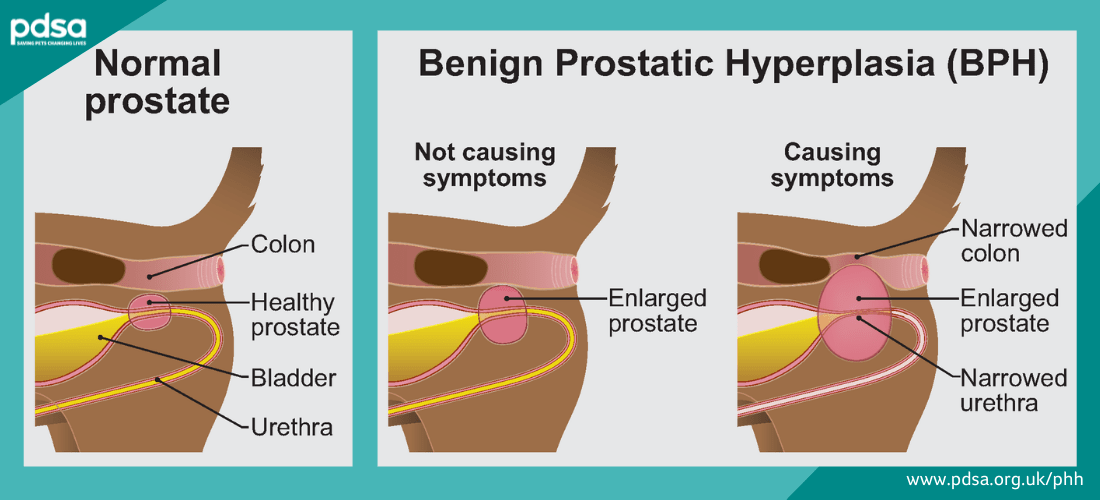Benign Prostatic Hyperplasia (BPH) in Dogs
Overview
- The ‘prostate’ is a gland that sits just inside the anus of male dogs.
- ‘Benign Prostatic Hyperplasia’ (or ‘BPH’) is when the prostate gland becomes enlarged because of overstimulation by testosterone from the testicles.
- BPH is a condition that develops in most uncastrated dogs at some point throughout their life, but only tends to cause a problem if it becomes severe.
- When BPH does start cause a problem, it can usually be cured by castration/neutering.

The prostate gland is a small reproductive gland that sits just inside the anus (bottom). It produces fluid for sperm to travel in, and is controlled by a hormone called testosterone – which is produced in the testicles.
Uncastrated dogs produce a lot of testosterone, which over time, can cause their prostate gland to become larger than normal – known as ‘benign prostatic hyperplasia’ or ‘BPH’. BPH is an extremely common condition that develops in nearly all uncastrated male dogs at some point in their life (most common after 7 years old). Fortunately, in most cases it doesn’t cause a problem, however, in some dogs, it can cause the prostate to become so big that it gets in the way of being able to pee and poo (see image above). In severe cases of BPH, the prostate can also become infected (a condition called prostatitis), or develop cysts (fluid filled pockets) which cause further problems.
When to contact your vet
Contact your vet if you notice any of the symptoms of BPH, especially if your dog is struggling to pee. The sooner the problem is treated, the easier it is likely to be to treat. Contact your vet immediately if your dog is straining but isn’t passing any urine.
You know your dog best, always contact your vet if you’re concerned.
Diagnosis
If your vet suspects BPH after examining your dog, they might suggest the following investigations:
- Physically checking the prostate (usually done during the clinical examination but sometimes under anaesthetic if it’s particularly painful)
- A urine sample
- Blood tests
- X-rays
- An ultrasound scan
- Taking a sample from your dog’s prostate
- Referral for specialist tests such as MRI or CT scans
Treatment
Castration
The simplest and quickest way to treat BPH is to castrate your dog. Once their testicles have been removed, they will stop producing testosterone and their prostate will start shrinking. The effects of the castration should be noticeable within a week or two, and the prostate should be back to its normal size within 8-10 weeks of the operation (this varies depending on how big it was to begin with).
Hormone therapy
If castration is not an option for your dog, hormone therapy might be a good alternative. Hormone therapy will stop them producing testosterone and can be given as an injection, implant or tablets.
Other necessary treatment
If your vet also discovers that your dog is suffering from prostatic cysts (fluid filled structures inside the prostate) or an infection (prostatitis), it’s likely that they will need other treatment such as antibiotics and anti-inflammatories.
Prevention
The best way to prevent your dog from developing benign prostatic hyperplasia is to castrate them. You can find out more about the benefits of castration in our article ‘neutering your dog’.
Cost
Treatment for Benign Prostatic Hyperplasia (BPH) can be as little as the cost of castrating your dog. Hormonal therapy tends to be more expensive and is an ongoing cost. It’s important to speak openly to your vet about your finances, the cost of treatment, as well as what you think is right for your dog. There is often more than one treatment option, so if one doesn’t work for you and your dog then your vet may be able to offer another.
When you welcome a new dog into your life, consider getting dog insurance straight away before any signs of illness start. This will give you peace of mind that you have some financial support if they ever get sick.
Published: November 2021
Did you find this page useful?
Tell us more
Please note, our vets and nurses are unable to respond to questions via this form. If you are concerned about your pet’s health, please contact your vet directly.
Thank you for your feedback
Want to hear more about PDSA and get pet care tips from our vet experts?
Sign up to our e-newsletter
Written by vets and vet nurses. This advice is for UK pets only. Illustrations by Samantha Elmhurst.

